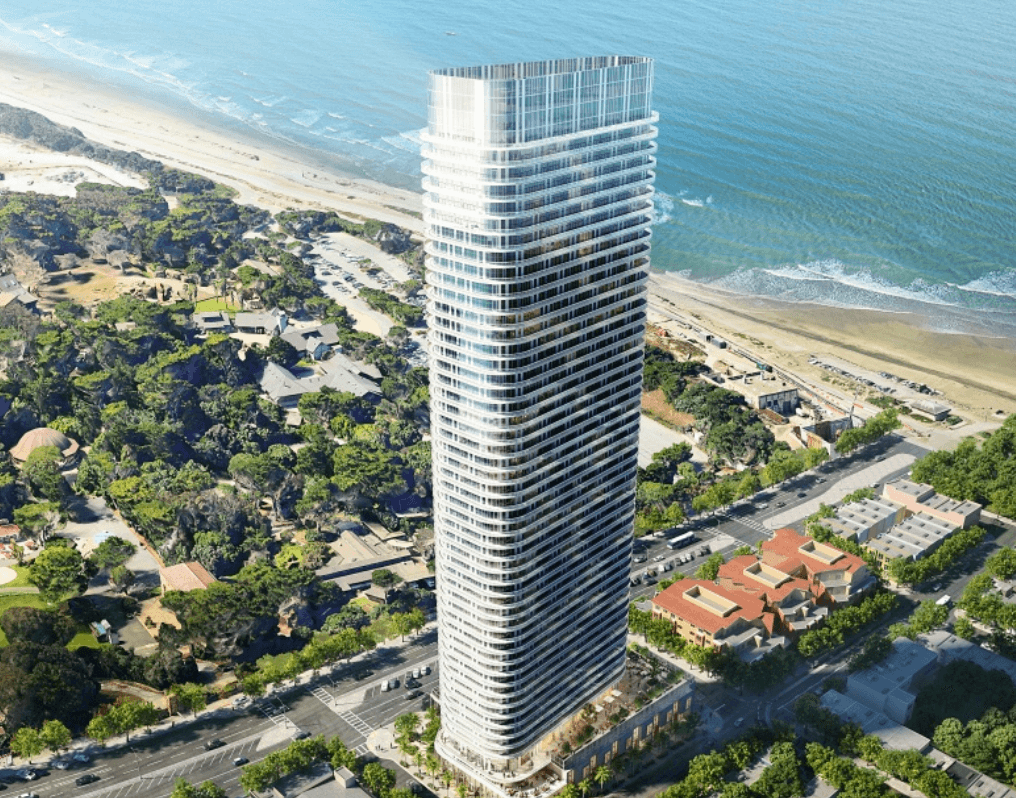Note from Our Neighborhood Voices: We all know we need more affordable housing all over California – especially in San Francisco. We just believe that Sacramento politicians should not give for-profit developers a blank check to build luxury towers without ANY community input. We believe neighbors and their local elected leaders have the right to shape the future of their own communities. Our coalition is surging. Join us and help fight back for our neighborhood voice using the form at the bottom of this page.
This article originally appeared in the San Francisco Chronicle
By JK Dineen
The latest renderings of the proposed 50-story beachfront tower in San Francisco’s Sunset District had barely been filed with city planners last week when groups opposed to dense residential development sprang into action.
Within hours, the group “Our Neighborhood Voices,” which opposes Sacramento’s efforts to force cities to increase housing production, pushed out fundraising ads on social media showing the proposed 589-foot tower rising from the low-slung waterfront community.
“This isn’t a joke,” warned the ad. “It’s a real proposal in San Francisco and neighborhoods all over California could be next — including yours.”
At a time when Mayor London Breed and city staffers are working to meet state housing mandates by upzoning the west side’s commercial corridors — San Francisco is supposed to plan for 82,000 units over the next eight years — opponents to that effort have grabbed hold of the proposed 680-unit tower at 2700 Sloat Blvd. and are using it as a 589-foot cudgel with which to bash the broader policy objectives.
Sunset resident Renee Lazear, an organizer for the group Save Our Neighborhoods San Francisco, said the tower rendering “woke up the neighborhood.” She opposes plans to put multi-family apartment buildings on the city’s westside and warns that the tower is “the kind of building the state of California wants to build everywhere.”
“It is pretty much the talk of the neighborhood,” she said. “You can’t avoid it. It comes up in every meeting I’m in, among my social circle, my friends, on Nextdoor. Everywhere you go.”
The timing of the proposal for the site, currently the Sloat Garden Center, could not be worse for city planning staff and for Sunset District Supervisor Joel Engardio, who are trying to build community support for a rezoning that would allow five or six story apartment blocks along Judah, Irving, Taraval, and 19th Avenue.
Engardio, who was elected supervisor with the support of the pro-housing YIMBY movement, called the 2700 Sloat proposal “a bad PR stunt from a frustrated developer who has not been getting his way.”
“It’s causing people unnecessary concern and anxiety,” he said. “Everything about it is farcical and ridiculous but it’s distracting from the real work we need to do to build real housing that is actually needed to allow families to stay in San Francisco.”
Whether or not the proposed building is legal comes down to an interpretation of an obscure zoning rule around “bulk code,” or how many square feet of building can be squeezed onto its footprint. The developer argues that the project would actually be four razor-thin towers sitting on a single podium. Combined they would violate bulk code requirements, but individually they comply, the developer argues.
So far, the city Planning Department’s zoning administrator has rejected the argument, a decision the developer has appealed to the Board of Appeals. That hearing is on July 26th.
Planning Director Rich Hillis said the one-acre garden center is an appropriate place for density — within reason.
“We are trying to be aggressive and thoughtful about where we put additional housing,” he said. “We all question whether this is a serious proposal and what the motivation is because it doesn’t feel real.”
Planning Department Chief of Staff Dan Sider said the proposed tower is “drastically out of step with what the state and city allows.”
“The disservice that this pipe dream of a project is causing to the city and state’s effort to keep pace with housing demand is worrisome to say the least,” he said. “It’s a lot of fear-mongering.”
Whatever the outcome of the Ocean Beach tower fight, it’s likely to be an opening salvo in the battle over the broader rezoning of the westside, which will happen over the next six months.
Lazear’s organization, Save Our Neighborhoods, has gathered 3,000 signatures opposing the project. And she said the Sloat project is making residents aware of the upzoning likely to be adopted early next year. Lazear said she would only support two-story townhomes on the Sloat site, and in the Sunset, generally.
Even eight or 10 stories, she said, is “too big and would be more appropriate in SoMa or downtown.”
“People move out here because they don’t want to live in a high-rise condo,” she said. “People don’t want to live in Sacramento’s idea of some planned modern utopia.”
Engardio said that the extremists on both sides of the housing debate are enjoying the Sloat Boulevard battle, but that it’s not helping the city deal with the housing issues he hears from Sunset District constituents — including the lack of elevator buildings suitable for seniors or the deficit of two-bedroom apartments for young families.
He said extreme YIMBYs and ardent opponents to development are both using the proposal to score political points.
“What is lost is the vast majority of people in the middle who want a functioning city,” he said. “We all need to take a breath and use some common sense.”
YIMBY Action Executive Director Laura Foote argued that the developer only resorted to the 55-story tower after neighbors had opposed two earlier proposals, for an eight-story, 213-unit building and a 12-story, 400-unit building.
She said the concerns that the 50-story tower would cause a big “backlash” against pro-housing policies is overstated.
“People have been worried about backlash since the beginning of the pro-housing movement,” she said. “The NIMBYs will obviously want to use this project to freak people out, but I don’t think they are going to be very successful.”
She said hand-wringing about neighborhood character and architectural aesthetics is “not very compelling” when compared with a housing deficiency that has forced many into homelessness.
Meanwhile, developers Raelynn and John Hickey, will make their case on July 26 before the Zoning Board of Appeals — and it will not be the first time the couple has clashed with city officials.
In 2004, John Hickey proposed three 500-foot towers on India Basin in San Francisco’s Bayview-Hunters Point neighborhood. While that project was shot down by city planners, Hickey was convicted by a federal jury on two counts of securities fraud and eight counts of mail fraud after a three-week trial in U.S. District Court in San Francisco. He was found guilty of defrauding more than 700 investors and sentenced to 97 months in prison.
In a recent text, Raelynn Hickey said she has “been involved with affordable housing most of my life and it gives me great pleasure to have an opportunity to take part in developing more of this badly needed housing stock.”
Hickey said, in texts, she has “surrounded” herself with “some of the best quality consultants in the business, including architects, civil engineers, (mechanical) engineers, affordable housing consultants, land use attorneys, litigation attorneys, marketing consultants, land use attorneys, and many more.”


Leave a Reply